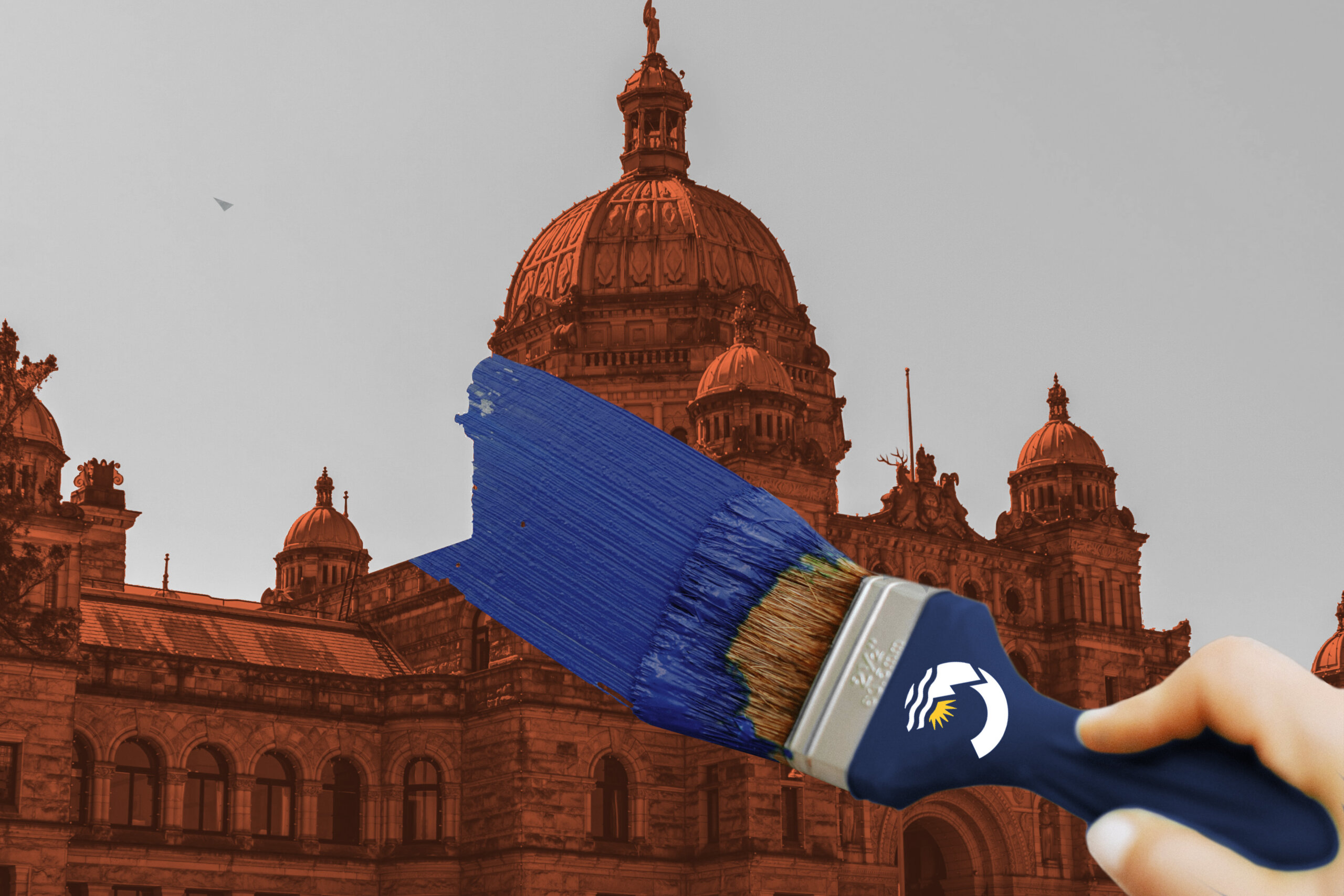In this year of high-stakes elections, the choice facing British Columbian voters on October 19 boils down to a familiar binary: acknowledge reality or embrace denial.
Embodied by the BC NDP and the Conservative Party of BC respectively, that contrast permeates almost every field of public policy. But it is starkest, and most consequential, in questions of the land itself: BC is on the front line of climate disaster, hammered by unprecedented wildfires, heat domes, drought, and atmospheric rivers. The province is also grappling with the collapse of a resource base that sustained its economy for much of the last century: some 80 percent of the province’s primary forest—an area bigger than California—has been logged, and wild salmon populations are at less than a tenth of their pre-industrial abundance, to name two prominent examples. At the same time, BC has exhausted the legal strategy of denying Indigenous rights and title to over 200 First Nations—an approach that cost the province and First Nations alike untold billions in legal fees and squandered development opportunities.
Who will lead the province through this maelstrom for the next four years? One option is the BC Conservatives, whose leader, John Rustad, proudly and consistently denies climate change—“How is it we have convinced carbon-based beings that carbon is the problem?” he quipped in a September 2 episode on Jordan Peterson’s podcast—blames forestry’s collapse on environmental policies designed to save what’s left, and casts Indigenous rights and title as “a direct assault on individual property rights,” as he told Peterson. There’s a dark irony in that last one, given Rustad’s former post as minister of Aboriginal relations and reconciliation.
Then there’s the NDP. Now in their seventh year of government, the BC NDP have made this province the last progressive stronghold in Canada. Their biggest accomplishment has arguably been their work on reconciliation. It has been deeply intertwined with the province’s environmental and industrial crises, and it has been a central target of the Conservatives’ race-baiting campaign, so let’s start there.
In 2019, BC became the first jurisdiction on earth to write the United Nations Declaration on the Rights of Indigenous Peoples into domestic law. That law—the Declaration on the Rights of Indigenous Peoples Act, or DRIPA—commits the province to sharing decision-making power over land-use matters with First Nations throughout the province. This wasn’t some altruistic gesture; it was a pragmatic response to a string of provincial Supreme Court defeats the BC government has suffered over the past three decades (Delgamuukw, Haida, Tsilhqot’in, Yahey), twinned with an equally long history of First Nations slowing or entirely cancelling huge industrial projects (Northern Gateway Pipeline, Trans Mountain, Coastal GasLink).
The reason First Nations keep winning is that almost all of BC was taken from them without a treaty; that gives them a strong legal position in land disputes. In signing DRIPA, the NDP codified the decision to pursue negotiation over litigation. “Let’s sit down with the title holders whose land we want to conduct economic activity on and create partnerships as a way forward,” then premier John Horgan said shortly after signing the act, according to the CBC. “Without [DRIPA], legislation is the way forward for investment. We’ve seen that with the Trans Mountain pipeline: court case after court case after court case.”
Horgan was no environmental hippy. He spent his formative years working in a remote pulp mill on BC’s coast, and his Vancouver Island riding hosted one of the biggest acts of civil disobedience in Canadian history, the anti–old growth logging protests at Fairy Creek, which pitted Horgan and the Pacheedaht First Nation—whose hereditary and elected leadership alike supported logging—against environmental protesters who also had Indigenous leaders in their ranks. That affair exemplified the tightrope the NDP has been trying to walk since forming government in 2017: How to protect industry, the environment, and First Nations when those three interests are frequently at odds?
DRIPA has been the key to squaring that circle. Horgan’s successor, David Eby, has doubled down on what Horgan began. Since Eby took office two years ago, an extraordinary series of agreements has spread across the province, transforming the way First Nations, industry, and the Crown share power and extract resources. The entire archipelago of Haida Gwaii is now under Haida authority, but forestry continues under joint Haida–BC control (and not a single non-Indigenous property holder has or will lose their title). The Great Bear Sea initiative placed 100,000 square kilometres of BC’s north coast under the shared authority of seventeen coastal First Nations and federal and provincial government agencies; commercial fishing will continue (more than 30 percent of that industry’s workforce is Indigenous) but under far more targeted conditions than before. In the vast gas fields of northeast BC, a region drawn and quartered by seismic lines, the NDP chose not to appeal the 2021 court decision that forced a halt to all new drilling permits until the Blueberry River First Nation negotiates a mutually acceptable way forward with industry and government alike. “What DRIPA is trying to do is keep it out of the courts, to recognize that First Nations have rights, title, sovereignty, and self-determination,” Terry Teegee, regional chief of the BC Assembly of First Nations, told me. “And to realize that even in the court declarations when First Nations win, the judge says, ‘You guys have to work this out.’”
My conversation with Teegee was one of several I’ve had this year with Indigenous leaders from across the province, who all emphasized the impact and global relevance of DRIPA. “It is historic, what BC is trying to do,” said Adam Olsen, a member of the BC Greens from the Tsartlip First Nation. “They’re unpacking about 175 years of public policy.”
“What we see in BC is such a deliberate, intentional approach to implement the declaration,” said Sheryl Lightfoot, an Anishinaabe scholar who teaches in the department of political science and the School of Public Policy and Global Affairs at the University of British Columbia and is an expert member of the UN’s Expert Mechanism on the Rights of Indigenous Peoples. “Both [the] substance—the actual rights implementation—but also the process—how First Nations work with government and private industry—[have] changed and shifted in a way that’s much more democratic, much more egalitarian.”
“It’s unique—anywhere in the world,” said chief Teegee. “We’re really, I suppose, leading the way.”
DRIPA is also guiding the transformation of the entire forest industry. The NDP has placed a moratorium on old-growth logging throughout the province, subject to First Nations approval; if a nation wishes for logging to continue in their territory, as in Fairy Creek, that’s their right; if not, they only have to say no. And as major logging corporations move their operations to the southern US, where trees grow much faster, many First Nations are also acquiring forestry tenures and proceeding with more sustainable forestry practices in their own backyards.
Contrary to how Rustad and the Conservatives portray it, this turn of affairs is not a punishment for non-Indigenous communities. Teegee, himself a former professional forester, described to me how communities like his home of Takla First Nation in central BC are stepping in to fill the void large logging corporations like Canfor are leaving behind as they close sawmills and transfer their operations to the US. “A lot of the contracting or people we hire are from local communities such as Fort St. James or Prince George,” Teegee said. “So, really, Prince George [in central BC and a major centre for the logging industry] is benefiting from many First Nations that live in and around the area, and the vast majority of what is spent here from those resources stays in this region.” Teegee was pointed in his critique of the big companies that have long controlled BC’s forests. “If you look at the way corporations do it,” he said, “the vast majority of their profits go to some shareholder. And I don’t believe any shareholder has interests in any local community.”
In 2022, the NDP created the new Ministry of Water, Land, and Resource Stewardship to oversee the province’s sprawling land-use transition. The minister in charge is Nathan Cullen. “We have to be a more intelligent resource economy,” Cullen told me earlier this year. Over the course of an hour-long conversation held in person at the BC legislature, Cullen repeatedly emphasized his desire for industry to flourish—within the bounds of ecological reality. “The environment is telling us we’re coming up against the limits of what you can do sustainably,” Cullen said. “Whether it’s climate change, declining salmon, more expensive forestry operations, forest fires—the list is pretty long in terms of the feedback that we’re getting. So the important thing to do is pay attention to feedback and then evolve with it rather than deny its existence.”
But denial is at the heart of Rustad’s pitch to voters. “You’ve got a government, quite frankly, that’s more focused on the environmental movement than they are on families and workers and communities,” he said in his conversation on Peterson’s podcast. Rustad promises to revoke DRIPA (despite voting for it himself five years ago) and reverse the optimistic, if fragile, approach to resource management that is just starting to take hold in this province. As per his telling, this will usher in a new era of prosperity. In reality, it will usher in a fresh wave of legal battles, civil disobedience, and investment uncertainty. It would also unleash a fresh wave of clearcutting, commercial fishing, and other resource extraction that will devastate BC’s fractured landscapes, hastening the demise of the very industries Rustad wants to save.
That isn’t a moral judgment that ignores economic imperatives. Under the NDP, BC is the only province in Canada other than Ontario with a triple-A credit rating from Moody’s. The province is the third least indebted and holds some of the highest average wages in the country.
Like many provinces across Canada, BC is dealing with a wide and troubling range of systemic breakdowns, including in housing, health, and education. What these all have in common is the need for new approaches rather than a return to the twentieth-century paradigms that got us here in the first place.
More than any other government in Canada, the BC NDP has embraced this painful reality and responded with aggressive new solutions. As Conservative denial sweeps much of the rest of the country, BC has become the most powerful stronghold of progressive politics in Canada. That’s what’s on the ballot in October. It’s never mattered more.
With thanks to the Trottier Foundation for helping The Walrus publish writing on climate change and the environment.





